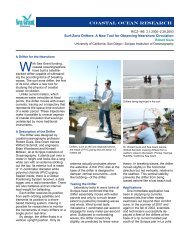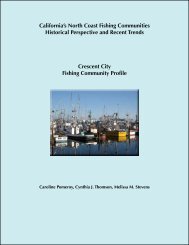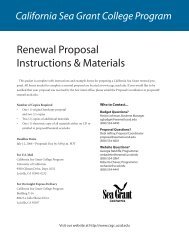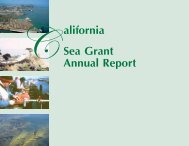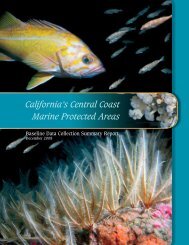PAT-UC Covers - California Sea Grant - UC San Diego
PAT-UC Covers - California Sea Grant - UC San Diego
PAT-UC Covers - California Sea Grant - UC San Diego
You also want an ePaper? Increase the reach of your titles
YUMPU automatically turns print PDFs into web optimized ePapers that Google loves.
Rapid Response to the First Caulerpa Invasion in North America<br />
Another highlight of CSG’s aquatic nuisance species program has been our<br />
involvement combating the first documented infestations of Caulerpa taxifolia<br />
in North America. The rapid response to the discovery, along with concerted<br />
efforts by state, federal and local entities, has been key in preventing the seaweed<br />
from spreading to the open ocean – a major victory given the disastrous spread of<br />
Caulerpa in the Mediterranean.<br />
<strong>Sea</strong> <strong>Grant</strong> funded Susan Williams, Director of the Bodega Marine Laboratory of<br />
<strong>UC</strong> Davis, to map the potential geographic range of Caulerpa based on available<br />
light, salinity and water temperature. Although Caulerpa is native to the tropics,<br />
her research showed that the invasive strain in Southern <strong>California</strong> is capable of<br />
spreading as far north as Washington – a sobering discovery that underscored the<br />
urgent need for containment.<br />
In other <strong>Sea</strong> <strong>Grant</strong>-funded work, Steven Murray of CSU Fullerton and <strong>Sea</strong> <strong>Grant</strong><br />
trainee Susan Frisch surveyed local aquarium stores to document the seaweed’s<br />
commercial availability. Half of the stores were selling seaweeds of the genus<br />
Caulerpa, including C. taxifolia. The <strong>California</strong> legislature has since banned the<br />
importation, possession and intrastate sale of nine Caulerpa species. The new law,<br />
it is hoped, will significantly reduce the chances of new introductions. The first<br />
introductions were likely caused by the dumping of home aquaria into nearby<br />
waterways.<br />
Because public education<br />
is so important, <strong>Sea</strong> <strong>Grant</strong><br />
funded biologist Enric Sala<br />
of Scripps Institution of<br />
Oceanography to create<br />
an educational display<br />
on Caulerpa for the Birch<br />
Aquarium in La Jolla, which<br />
has more than 350,000<br />
visitors per year. CSG also<br />
hosted the first International Caulerpa taxifolia Conference in 2002 and produced<br />
the conference proceedings on CD. <strong>Sea</strong> <strong>Grant</strong> communications wrote two feature<br />
stories on Caulerpa, which have been posted on CSG’s website and published in<br />
Intercoast Network, an international newsletter on coastal management published by<br />
the University of Rhode Island.<br />
Chinese Mitten Crabs<br />
Researchers at <strong>UC</strong> <strong>San</strong>ta Barbara dissected several hundred Chinese mitten crabs<br />
and crayfish captured from the <strong>San</strong> Francisco Bay-Delta to look for evidence of<br />
lung flukes – dangerous human parasites common in Asia where mitten crabs are a<br />
delicacy. The project was motivated by concerns that the illegal sale of locally caught<br />
mitten crabs might be spreading parasites. The scientists found no evidence of<br />
parasitism in the crustaceans, but they did find all the requisite hosts that are needed<br />
to support a future infestation. This finding is significant given the push to open a<br />
commercial mitten crab fishery.<br />
European Green Crabs<br />
<strong>Sea</strong> <strong>Grant</strong> funded two researchers at <strong>UC</strong><br />
<strong>San</strong>ta Barbara to investigate the efficacy<br />
and safety of using a biological control<br />
agent – a parasitic barnacle – to reduce<br />
the number of European green crabs.<br />
The scientists found the parasite is not<br />
host-specific enough to warrant its use,<br />
European Green Crab (Photo <strong>UC</strong>SB)<br />
as it was able to infect the commercially<br />
important Dungeness crab. The findings<br />
received widespread media coverage from<br />
venues such as the Los Angeles Times and<br />
National Public Radio and steered resource<br />
managers away from investing in a plan<br />
that would have likely backfired, resulting<br />
in unintended and costly repercussions<br />
(see project R/CZ-162).<br />
Exotic Invertebrates and Wetland<br />
Restoration<br />
With <strong>Sea</strong> <strong>Grant</strong> funding, researcher<br />
Lisa Levin of Scripps Institution of<br />
Oceanography showed that a burrowing<br />
Australian isopod (Sphaeroma quoyanum)<br />
undercuts marsh banks, increasing<br />
sediment loss and erosion by as much as<br />
250 percent. The isopod, however, cannot<br />
invade gently sloping marsh banks, but<br />
only steep, near-vertical ones. With the<br />
knowledge that marsh banks should be<br />
built to slope gently, wetlands can be<br />
constructed (or restored) to be more<br />
resilient to exotic invaders. Levin’s findings<br />
have been incorporated into the long-term<br />
planning documents of the Port of <strong>San</strong><br />
<strong>Diego</strong> and the U.S. Navy for <strong>San</strong> <strong>Diego</strong> Bay<br />
(see project R/CZ-150).<br />
21<br />
<strong>California</strong> <strong>Sea</strong> <strong>Grant</strong>: 1998-2003



